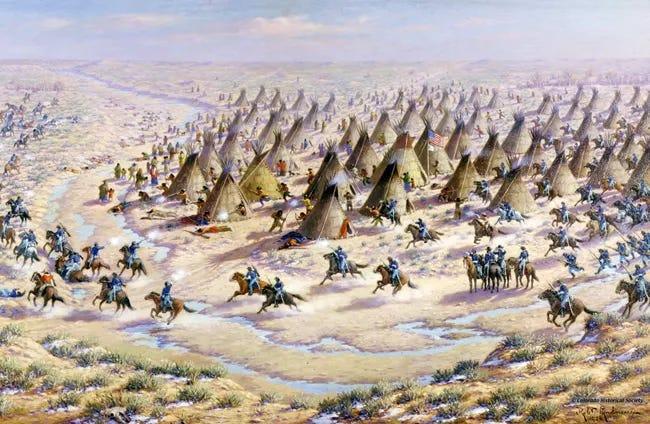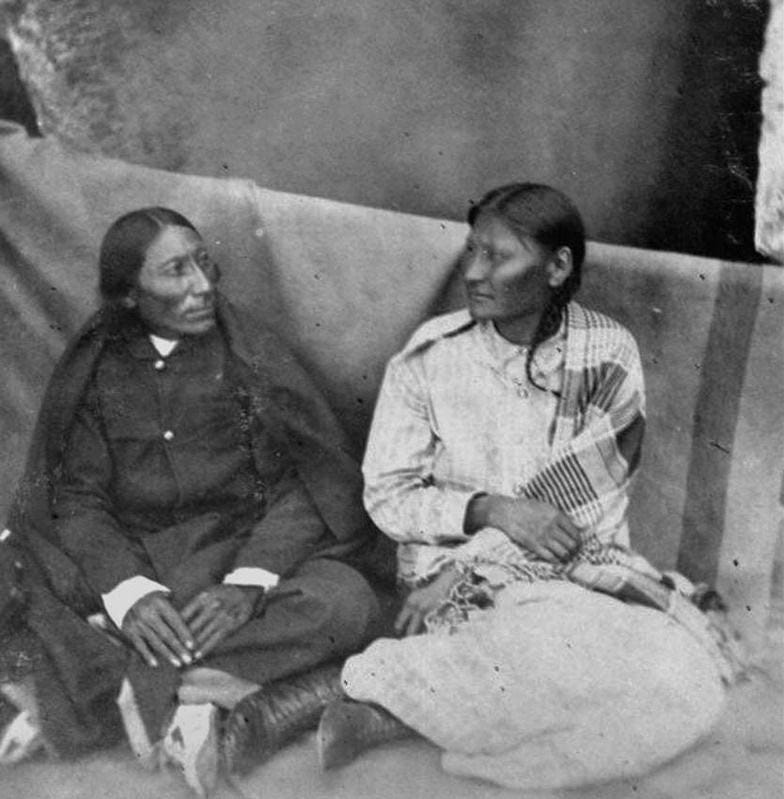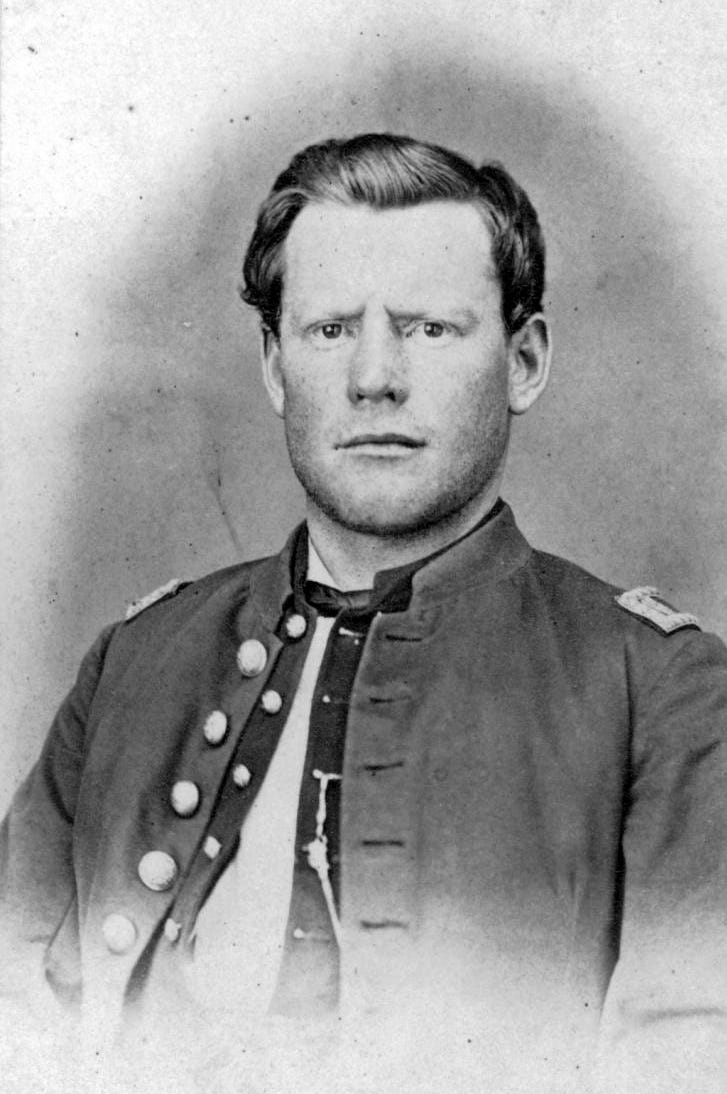Painting of the attack on Sand Creek, by Robert Lindneaux, 1936
*It’s a safe bet that anything containing the word ‘massacre’ in the title won’t be a happy, light-hearted reading. Much of what follows is graphic and disturbing. With this caveat in mind, if you are in a sensitive mood, you may want to skip this one.
“Every day
On our fellow man we prey.
Dog eat dog
To get by
Hope you like my genocide.” The Offspring
One hundred and fifty-nine years ago today, the Sand Creek massacre took place. It was November 29, 1864. A gold rush had brought thousands of settlers to Colorado, and it didn’t take long for tensions to build up between the new arrivals and the tribes who lived there, in particular the Cheyenne. Competition for land and resources, fraudulent treaties, racism, cultural misunderstandings, fake news, and some horrible individuals all contributed to lead the tribes and the settlers on a collision course.
For anyone interested in an in-depth telling of this story, I covered this tale back in episode 32 A of History on Fire. Rather than recapping the whole thing here in written format, over the next few lines I’ll remember what happened at Sand Creek with some quotes and isolated stories.
The first few offer a window into the genocidal rhetoric at the roots of the massacre:
-Major Jacob Downing declared, “I believe now it is but the commencement of war with this tribe, which must result in their extermination.”
-Downing also said, “I think and earnestly believe the Indians to be an obstacle to civilization, and should be exterminated.”
-In an article arguing that it didn’t matter if a particular Cheyenne village had been peaceful and never fought the settlers, an editorial in the Nebraska City News stated, “At present we are in favor of the Rev. Col. Chivington and a religious extermination of the Indians generally.”
-Rev. Col. John Chivington was a Methodist pastor who led the Colorado militia to carry out the Sand Creek massacre and kill unarmed women and kids. When an officer tried to convince him not to attack that particular village, since the people there had expressed a desire to remain at peace with the United States and had even protected some soldiers in a previous confrontation, Chivington replied, “Damn any man who sympathizes with Indians! ... I have come to kill Indians, and believe it is right and honorable to use any means under God's heaven to kill Indians… Kill and scalp all, big and little; nits make lice.”
-A few months following the massacre, Senator James Doolittle had a public meeting with Governor Evans in a theater in Denver to discuss how to handle the relations with the surviving Cheyenne. Pointing out that the U.S. government had taken away the Natives’ land and livelihood, Doolittle asked what he thought was a rhetorical question. He asked the audience whether the right thing to do would be to help the Natives on the reservations or exterminate them. The audience in the theater exploded in screams of “Exterminate them! Exterminate them!”
These next few quotes describe only a few of the horrors that took place at Sand Creek:
-When the Cheyenne panicked seeing the soldiers and militiamen surrounding them, their leader, Black Kettle, tried to reassure them saying he was flying an American flag and a white flag on his tipi. Clearly—he reasoned—the soldiers would see the flags, realize this was a peaceful camp and leave them alone. It wasn’t long after this that the bullets started flying.
-Another Cheyenne leader named White Antelope had rushed to the soldiers with his hands raised while pleading to stop firing. He was shot dead and scalped. His nose, ears and testicles were cut off. His testicles were later used by a soldier to make a tobacco pouch.
-A trapper and translator named John Smith had this much to say regarding the conduct of the soldiers toward the Cheyenne, “All manner of depredations were inflicted on their persons. They were scalped, their brains knocked out; them used their knives, ripped open women, clubbed little children, knocked them in the head with their guns, beat their brains out, mutilated their bodies…”
-A scout named Robert Bent testified, “There were some 30 or 40 squaws collected in a hole for protection; they sent out a little girl about six years old with a white flag on a stick…” [the idea being that seeing defenseless little girl, the soldiers wouldn’t feel threatened and would be more willing to listen] “…she had not proceeded but a few steps when she was shot and killed.”
-Another witness reported, “A group of soldiers paused amid the firing to take turns profaning the body of a comely young squaw, very dead… Someone had the notion that it would be artistic work to slice away the breasts of the Indian women. One breast was worn as a cap, another was seen stretched over the bow of a saddle.”
-An officer named Silas Soule wrote in a letter, “A woman was cut open, and a child taken out of her, and scalped.”
-Major Scott Anthony testified, “There was one little child, probably three years old, just big enough to walk through the sand. The Indians had gone ahead, and this little child was behind, following after them. The little fellow was perfectly naked, travelling in the sand. I saw one man get off his horse at a distance of about seventy-five yards and draw up his rifle and fire. He missed the child. Another man came up and said, 'let me try the son of a b-. I can hit him.' He got down off his horse, kneeled down, and fired at the little child, but he missed him. A third man came up, and made a similar remark, and fired, and the little fellow dropped.” Yeah… you heard right, grown men in uniform using a three-year old for target practice.
Mochi’s story:
-A 24-year-old Cheyenne woman named Mochi was in her tipi at the start of the massacre. A soldier broke inside, shot her mother in the head, and tried to rape Mochi. Mochi, however, was able to grab her grandfather’s rifle and killed her attacker. She became a warrior after this and fought for the following 11 years.
Consequences:
By massacring a peaceful camp, Chivington and his men radicalized those Cheyenne who until that point had advocated for peace. The result is that the moderates ended up joining the resistance against US expansion.
Captain Silas Soule and Lieutenant Joseph Cramer:
In the midst of the horrific conduct of most soldiers present at Sand Creek, two officers deserve to be remembered for their heroism. Captain Silas Soule and Lieutenant Joseph Cramer ordered the men under their direct command not to participate in the massacre. Fully aware of the risks they were taking, they even testified against Chivington during the following investigation. Soule’s choice ended up costing him his life when a couple of Chivington’s sympathizers murdered him. Both Soule and Cramer are still honored on the anniversary of the massacre by the descendants of the survivors of Sand Creek with a ceremonial run and prayers. At some point, I’ll write more on them, since if you are looking for heroic figures in history, you can do a lot worse than reading about Silas Soule and Joseph Cramer.








As always, you bring the emotion into history. This was very moving as was the podcast on the subject. Shocking to imagine anyone wearing a US uniform performing these acts, but I would love to read more about Soule and Cramer. Recommended reading?
Thank u Daniele. Lest we ever forget.
‘There will be blood.’